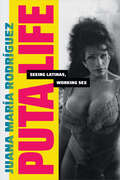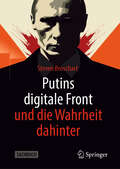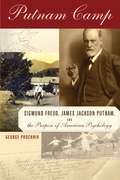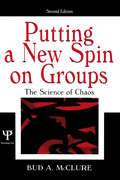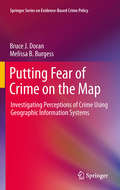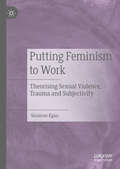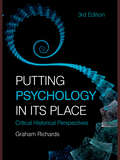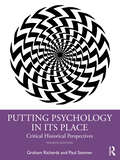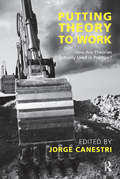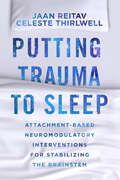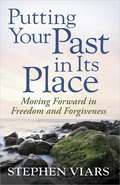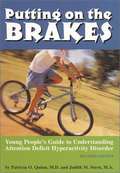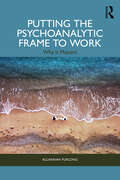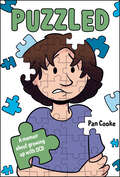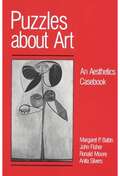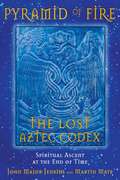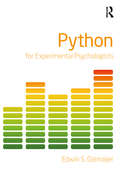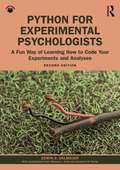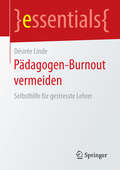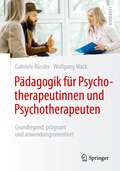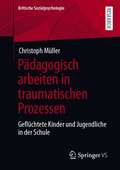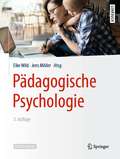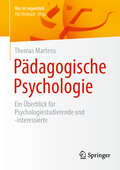- Table View
- List View
Puta Life: Seeing Latinas, Working Sex (Dissident Acts)
by Juana María RodríguezIn Puta Life, Juana María Rodríguez probes the ways that sexual labor and Latina sexuality become visual phenomena. Drawing on state archives, illustrated biographies, documentary films, photojournalistic essays, graphic novels, and digital spaces, she focuses on the figure of the puta—the whore, that phantasmatic figure of Latinized feminine excess. Rodríguez’s eclectic archive features the faces and stories of women whose lives have been mediated by sex work's stigmatization and criminalization—washerwomen and masked wrestlers, porn stars and sexiles. Rodríguez examines how visual tropes of racial and sexual deviance expose feminine subjects to misogyny and violence, attuning our gaze to how visual documentation shapes perceptions of sexual labor. Throughout this poignant and personal text, Rodríguez brings the language of affect and aesthetics to bear upon understandings of gender, age, race, sexuality, labor, disability, and migration. Highlighting the criminalization and stigmatization that surrounds sex work, she lingers on those traces of felt possibility that might inspire more ethical forms of relation and care.
Putin's Digital Front and the Truth Behind
by Steven BroschartPutin's war in Ukraine is not only fought on the battlefield. Combat also occurs on the digital front. Words and information are the ammunition of modern, hybrid warfare—against the opposing military, but especially against civilians. It is about manipulation and control. About confusion and distraction from what is really happening. However, the internet is used not only for propaganda but also for intelligence and logistics. In doing so, Russia leaves behind a lot of traces. Analyst Steven Broschart demonstrates in clear language that requires no prior knowledge which psychological and communicative means are employed at Putin's digital frontline.
Putins digitale Front und die Wahrheit dahinter
by Steven BroschartPutins Krieg in der Ukraine wird nicht nur auf dem Schlachtfeld ausgetragen. Gekämpft wird auch an der digitalen Front. Worte und Informationen sind die Munition der modernen, der hybriden Kriegsführung - gegen das gegnerische Militär, aber insbesondere gegen Zivilisten. Es geht um Manipulation und Kontrolle. Um Verwirrung und Ablenkung von dem, was wirklich geschieht. Doch das Internet wird nicht nur zur Propaganda, sondern auch für die Aufklärung und die Logistik genutzt. Und dabei hinterlässt Russland eine Menge Spuren. Analyst Steven Broschart zeigt konkret, welche psychologischen und kommunikativen Mittel an Putins digitaler Frontlinie zum Einsatz kommen.
Putnam Camp: Sigmund Freud, James Jackson Putnam and the Purpose of American Psychology
by George ProchnikWinner of the 2007 Gradiva AwardAn innovative work of biography that traces the lasting impact of the friendship between Sigmund Freud and pioneering American psychologist James Jackson Putnam. In 1909 Sigmund Freud made his only visit to America, which included a trip to "Putnam Camp"-the eminent American psychologist James Jackson Putnam's family retreat in the Adirondacks. "Of all the things that I have experienced in America, this is by far the most amazing," Freud wrote of Putnam Camp. Putnam, a Boston Unitarian, and Freud, a Viennese Jew, came from opposite worlds, cherished polarized ambitions, and promoted seemingly irreconcilable visions of human nature-and yet they struck up an unusually fruitful collaboration. Putnam's unimpeachable reputation played a crucial role in legitimizing the psychoanalytic movement. By the time of Putnam's death in 1918, psychoanalysis had been launched in America, where-in large part thanks to the influence of Putnam, and in a development Freud had not anticipated-it went on to become a practice that moved beyond the vicissitudes of desire to cultivate the growth and spiritual aspirations of the individual as a whole. Putnam Camp reveals details of Putnam's and Freud's personal lives that have never been fully explored before, including the crucial role Putnam's muse, Susan Blow-founder of America's first kindergarten, pioneering educator and philosopher in the American Hegelian movement-played in the intense debate between these two great thinkers. As the great-grandson of Putnam, author George Prochnik had access to a wealth of personal firsthand material from the Putnam family-as well as from the James and Emerson families-all of which contribute to a new and intimate vision of the texture of daily life at a moment when America was undergoing a cultural and intellectual renaissance.
Putting A New Spin on Groups: The Science of Chaos
by Bud A. McclurePutting a New Spin on Groups: The Science of Chaos, Second Edition continues to challenge orthodoxy and static ideas about small group dynamics. A primary goal is to offer an alternative model of group development that addresses three factors: *The model integrates old ideas from previous models of group development with new concepts from chaos theory and the work of Arthur Young. *The book emphasizes the importance of conflict in group development and recognizes that group growth--while progressive--is neither linear or unidimensional. *Particular attention is focused on how groups change, evolve, and mature. In addition, this book highlights certain group phenomena that have been given only cursory attention in many group textbooks, including women in authority, group metaphors, regressive groups, and the transpersonal potential of small groups. This book has been revised in response to feedback from reviewers and colleagues and includes new ideas, applications of chaos theory in social sciences, and thinking about group behavior. It is an intellectually challenging read with just the right amount of world application.
Putting Fear of Crime on the Map
by Melissa B. Burgess Bruce J. DoranSince first emerging as an issue of concern in the late 1960s, fear of crime has become one of the most researched topics in contemporary criminology and receives considerable attention in a range of other disciplines including social ecology, social psychology and geography. Researchers looking the subject have consistently uncovered alarming characteristics, primarily relating to the behavioural responses that people adopt in relation to their fear of crime. This book reports on research conducted over the past eight years, in which efforts have been made to pioneer the combination of techniques from behavioural geography with Geographic Information Systems (GIS) in order to map the fear of crime. The first part of the book outlines the history of research into fear of crime, with an emphasis on the many approaches that have been used to investigate the problem and the need for a spatially-explicit approach. The second part provides a technical break down of the GIS-based techniques used to map fear of crime and summarises key findings from two separate study sites. The authors describe collective avoidance behaviour in relation to disorder decline models such as the Broken Windows Thesis, the potential to integrate fear mapping with police-community partnerships and emerging avenues for further research. Issues discussed include fear of crime in relation to housing prices and disorder, the use of fear mapping as a means with which to monitor the impact of Closed Circuit Television (CCTV) and fear mapping in transit environments.
Putting Feminism to Work: Theorising Sexual Violence, Trauma and Subjectivity
by Suzanne EganThis book explores the place of feminism and uptake of trauma in contemporary work against sexual violence. Egan presents a refreshing alternative position on arguments about the co-optation or erasure of feminism within institutionalized, professionalized services for sexual assault victims. Using original research on Australian sexual assault services, Putting Feminism to Work effectively illustrates how feminist concepts and ideas have become routinized in contemporary services and enacted in daily practices with survivors and communities. The book engages with, yet resists, the notion that feminist engagement with knowledge (trauma) based in psychiatry and clinical psychology is incompatible with feminism or inevitably reduces sexual violence to a problem of individual healing. Indeed Egan argues that the productive ways practitioners integrate neurobiological understandings of trauma into their work suggests rich possibilities for reintroducing a non-essentialist biology of the body into feminist theories of sexual violence. Scholars, students and practitioners working in the fields of violence against women, sociology, women’s and gender studies, health, social work and policy studies, as well as the emerging field of sociologically informed trauma studies, will find this book of interest.
Putting Psychology in its Place, 3rd Edition: Critical Historical Perspectives
by Graham RichardsThe third edition of Putting Psychology In Its Place builds on the previous two editions, introducing the history of Psychology and placing the discipline within a historical context. It aims both to answer and raise questions about the role of Psychology in modern society, by critically examining issues such as how Psychology developed, why psychoanalysis had such an impact and how the discipline has changed to deal with contemporary social issues such as religion, race and gender. This new third edition contains two completely new chapters: "Emotion: The Problem or the Whole Point?" and "Funding and Institutional Factors." An expanded epilogue has also been added which incorporates a discussion of the conceptual issues raised in the book and the volume now corresponds with the new BPS requirements for undergraduate courses. Other chapters, including those on Psychology and the Brain, Social Psychology and the Psychology of Madness, as well as those on gender, religion and race, have been substantially revised. Putting Psychology In Its Place is imaginatively written and accessible to all. It is an invaluable introductory text for undergraduate students of the history of Psychology and will also appeal to postgraduates, academics and anyone interested in Psychology or the history of science.
Putting Psychology in its Place: Critical Historical Perspectives
by Graham Richards Paul StennerThis fourth edition of Putting Psychology in Its Place builds on the previous three in introducing the history of Psychology and placing the discipline within its historical and social contexts. Written by esteemed Psychologists Graham Richards and Paul Stenner, this crucial text aims both to answer and raise questions about the role of Psychology in modern society by critically examining issues such as how Psychology developed and why psychoanalysis had such an impact. It discusses enduring underlying conceptual problems and examines how the discipline has changed to deal with contemporary social issues such as religion, race and gender. The fourth edition features revised and updated chapters, though the core structure remains unchanged. The final chapter has been restructured and jointly re-written. This text was written to remain compatible with the British Psychological Society requirements for undergraduate courses and is imaginatively written and accessible to all. Putting Psychology in Its Place is an invaluable introductory text for undergraduate students of the history of Psychology and will also appeal to postgraduates, academics and anyone interested in Psychology or the history of science.
Putting Theory to Work: How are Theories Actually Used in Practice? (The Developments in Psychoanalysis Series)
by Jorge CanestriThis book contains a continuation and expansion of the topics covered in the author's previous book, Psychoanalysis: from Practice to Theory, about the use of theories in analytic practice. As a member of the International Psychoanalytical Association (IPA) Conceptual Research Committee and Chair of the Working Party on Theoretical Issues, the author, who teaches at Nanterre University, has studied and taught on the subject for several years, as well as writing many articles on it. The book will be particularly useful for psychoanalytical and psychotherapeutic societies, as well as for research committees.
Putting Trauma to Sleep: Attachment-Based Neuromodulatory Interventions for Stabilizing the Brainstem
by Jaan Reitav Celeste ThirlwellSleep disturbances and trauma are intrinsically linked—so why aren’t therapists trained in sleep repair? Anyone who has suffered from trauma knows what it means to have sleepless nights. In fact, research has shown that at the heart of both trauma and sleep disorders is a dysregulated brainstem with heightened sympathetic nervous system activity. Yet, current trauma treatments largely ignore this profound interconnection between trauma and sleep. Putting Trauma to Sleep proposes that incorporating a therapeutic TABS model (traumatic events, attachment disturbances, bodily symptoms, sleep repair), therapists can better aid their clients in both healing from trauma and restoring sleep. With practical clinical approaches and illustrative case examples, sleep specialists Jaan Reitav and Celeste Thirlwell demonstrate how therapists and their clients can integrate sleep repair into trauma work by enhancing parasympathetic nervous system tone and actively attending to shock reactions in the body. Dysfunctional sleeping patterns have been ignored for too long within the psychotherapy sphere; this indispensable resource will transform readers’ understanding of both sleep and trauma therapy.
Putting Your Past in Its Place: Moving Forward in Freedom and Forgiveness
by Stephen ViarsLives grind to a halt when people don’t know how to relate to their past. Some believe “the past is nothing” and attempt to suppress the brokenness again and again. Others miss out on renewal and change by making the past more important than their present and future. Neither approach moves people toward healing or hope. Pastor and biblical counselor Stephen Viars introduces a third way to view one’s personal history—by exploring the role of the past as God intended. Using Scripture to lead readers forward, Viars provides practical measures to understand the important place “the past” is given in Scripture replace guilt and despair with forgiveness and hope turn failures into stepping stones for growth This motivating, compassionate resource is for anyone ready to review and release the past so that God can transform their behaviors, relationships, and their ability to hope in a future.
Putting on the Brakes (Revised Edition): Young People's Guide to Understanding Attention Deficit Hyperactivity Disorder
by Patricia O. Quinn Judith M. SternExplains what attention deficit disorder is and how to treat it, discussing the cognitive and emotional aspects, what the medication options are, how to maintain positive relations with friends, and how to do well at school.
Putting the Psychoanalytic Frame to Work: Why it Matters
by Allannah FurlongPsychoanalysis is not just about what happens in the room – it is also about the structure that holds it all together. In Putting the Psychoanalytic Frame to Work, Allannah Furlong rethinks one of the traditional approaches to the analytic frame, arguing that disruptions – missed sessions, consent complexities, and third-party demands – are not necessarily obstacles but can be essential moments for deepening therapeutic insight.The book argues for a benevolent expectation of "trouble" as an inherent part of the therapeutic couple getting to know each other more deeply, and as an aspect which distinguishes the psychoanalytic frame from that usually taught by professional regulatory bodies. Furlong proposes that the analyst or psychoanalytic therapist welcome framework glitches as opportunities to "put the framework to work" rather than simply disposing of them as acting out or error. In so doing, the book invites clinicians to critically examine different theoretical approaches to the framework and its inevitable breaches.A why-to rather than a how-to book, Putting the Psychoanalytic Frame to Work aims to invigorate the practice of analysts everywhere – both seasoned and in training.
Puzzled: A Memoir about Growing Up with OCD
by Pan CookeGrowing up with undiagnosed OCD sure isn&’t easy, and here Pan Cooke shares his own experiences with that condition in a graphic-novel memoir that is as funny as it is powerfully candid and openhearted.Pan Cooke is ten years old when anxious thoughts begin to take over his brain like pieces of an impossible puzzle. What if he blurts out a swear word while in church? What if he accidentally writes something mean in his classmate&’s get-well card? What if his friend&’s racy photo of a supermodel ends up in his own homework and is discovered by his teacher? More and more, he becomes hijacked by fears that can only be calmed through exhausting, time-consuming rituals.Pan has no way of knowing that this anxiety puzzle and the stressful attempts to solve it are evidence of a condition called Obsessive Compulsive Disorder. This is his story of living with and eventually learning about OCD. Told with endearing honesty and humor, Puzzled shows the reader the importance of empathy for oneself and those going through something they don&’t yet understand.
Puzzles About Art: An Aesthetics Casebook
by John Fisher Anita Silvers Margaret Pabst Battin Ronald MooreThe first casebook for use in courses in aesthetics, Puzzles about Art provides more than 180 real and hypothetical cases that illustrate important principles and theories in the philosophy of art. With 25 illustrations as well as concrete examples from legal cases, museum experiences, newspaper articles and various media, including painting, sculpture, photography, music, drama, and film, Puzzles about Art helps students understand specific problems in the visual arts.
Pyramid of Fire: Spiritual Ascent at the End of Time
by John Major Jenkins Martin MatzThe first translation of a previously unknown Aztec codex and its initiatory teachings for 2012• Discloses the potential for great spiritual awakening offered at the end of the Aztec calendar cycle• Presents the only existing English-language transcription of the Aztec codex, with line-by-line commentary• Contains the epic poetry and metaphysical insights of Beat poet Marty Matz (1934–2001In 1961 an unknown Aztec codex was revealed to Beat poet and explorer Marty Matz by a Mazatec shaman in the mountains of Oaxaca, Mexico. Originally intended for dramatic performance, this codex presents a profound metaphysical teaching describing how the end of time will bring about a visionary ascent. At the behest of his Mazatec teacher, Matz transcribed this pictorial codex into a literary form that would preserve its initiatory teachings and reveal its secret meanings to a wider audience.Pyramid of Fire is an epic poem that provides a vehicle to transport the initiate into the higher realms of consciousness. It represents a barely surviving thread of teachings that have been passed down in secret since the time of the Spanish Conquest. Revealed are the techniques by which man is transported to the stellar realm after death via the solar energy within what the ancients called the “serpent of consciousness.” Line-by-line commentary by Matz and John Major Jenkins provides insights into the perennial philosophy contained in the codex and its relevance to our times.
Python for Experimental Psychologists
by Edwin DalmaijerProgramming is an important part of experimental psychology and cognitive neuroscience, and Python is an ideal language for novices. It sports a very readable syntax, intuitive variable management, and a very large body of functionality that ranges from simple arithmetic to complex computing. Python for Experimental Psychologists provides researchers without prior programming experience with the knowledge they need to independently script experiments and analyses in Python. The skills it offers include: how to display stimuli on a computer screen; how to get input from peripherals (e.g. keyboard, mouse) and specialised equipment (e.g. eye trackers); how to log data; and how to control timing. In addition, it shows readers the basic principles of data analysis applied to behavioural data, and the more advanced techniques required to analyse trace data (e.g. pupil size) and gaze data. Written informally and accessibly, the book deliberately focuses on the parts of Python that are relevant to experimental psychologists and cognitive neuroscientists. It is also supported by a companion website where you will find colour versions of the figures, along with example stimuli, datasets and scripts, and a portable Windows installation of Python.
Python for Experimental Psychologists: A Fun Way of Learning How to Code Your Experiments and Analyses
by Edwin S. Dalmaijer Rebecca Hirst Jonathan PeircePython for Experimental Psychologists equips researchers who have no prior programming experience with the essential knowledge to independently script experiments and analyses in the programming language Python. This book offers an excellent introduction, whether you are an undergraduate, a PhD candidate, or an established researcher.This updated edition is on Python 3 (the most current version). It starts by teaching the fundamentals of programming in Python and then offers several chapters on scripting experiments (displaying stimuli, obtaining and logging user input, precision timing, etc.) using the popular PsychoPy package. The remainder of the book is dedicated to data analysis and includes chapters on reading/writing to text files, time series, eye tracking, data visualisation, and statistics.Access to online support material enriches the learning experience with colour figures, example stimuli, datasets, scripts, and a portable Windows installation of Python. This book assumes no prior knowledge, and its informal and accessible tone helps readers with backgrounds in experimental psychology and cognitive neuroscience to quickly understand Python. It serves as a useful resource not only for researchers in these fields but also for lecturers instructing on methodology and data analysis.Python for Experimental Psychologists demystifies programming complexities and empowers researchers to proficiently conduct experiments and analyse their results.
Pädagogen-Burnout vermeiden: Selbsthilfe für gestresste Lehrer (essentials)
by Désirée LindeMit diesem essential erhalten gestresste Lehrer praxiserprobte Anleitungen, um einem drohenden Burnout vorzubeugen. Ausgehend von den stresserzeugenden, schulischen Arbeitsbedingungen geht es um grundlegende Veränderungen im Umgang des Lehrers mit sich selbst. Psychologische Anregungen und Hinweise zur Selbstreflexion von Ursachen für die Stressreaktionen dienen als Grundlage für ein neues Selbstcoaching. Dadurch verändert sich die Einstellung zu sich selbst und der Berufspraxis mit ihren besonderen Herausforderungen. Der Praktiker bekommt Tipps, insbesondere für die Gestaltung der Aufgaben abseits des Unterrichts, sowie zu Möglichkeiten der Schülermotivation und dem Umgang mit Verhaltensschwierigkeiten, da diese zu den Stressfaktoren gehören, die Lehrer und Erzieher am meisten belasten.
Pädagogik für Psychotherapeutinnen und Psychotherapeuten: Grundlegend, prägnant und anwendungsorientiert
by Wolfgang Mack Gabriele RösslerPsychotherapeutinnen und Psychotherapeuten behandeln Menschen, die durch familiäre Erziehung, durch schulische und berufliche Bildung geprägt wurden. Nicht selten gehen psychische Erkrankungen mit sozialen Problemen einher, die eine sozial- oder rehabilitationspädagogische Begleitung erfordern. In diesem Buch finden angehende Psychotherapeutinnen und Psychotherapeuten eine anwendungsorientierte Einführung in Erziehungs- und Sozialisationsprozesse sowie pädagogische Interventionen. Die Bedeutung der einzelnen Themen für die psychotherapeutische Praxis wird in jedem Kapitel gesondert erläutert.
Pädagogisch arbeiten in traumatischen Prozessen: Geflüchtete Kinder und Jugendliche in der Schule (Kritische Sozialpsychologie)
by Christoph MüllerDas Buch ist eine kritische und systematische Auseinandersetzung mit den schulpädagogisch sowie gesellschaftspolitisch hochaktuellen Themen Flucht und Trauma.Geflüchtete Kinder und Jugendliche befinden sich häufig in einem sequenziell traumatischen Prozess, zu dem neben den fluchtauslösenden Bedingungen und der Flucht selbst auch die Lebensbedingungen im Aufnahmeland gehören.Im Zentrum dieser Studie stehen die Fragen, wie sich die emotionalen Belastungen und potenziellen Traumatisierungen geflüchteter Schüler*innen in der Schule zeigen, wie sie sich im Erleben und Handeln der Lehrkräfte widerspiegeln und welche pädagogischen Konsequenzen sich daraus ergeben.Um dem nachzugehen, was es für die Lehrkräfte bedeutet, inmitten der traumatischen Prozesse der geflüchteten Schüler*innen pädagogisch zu arbeiten, wurden u.a. themenzentrierte Tiefeninterviews mit Lehrkräften geführt und tiefenhermeneutisch ausgewertet.Aufbauend auf den Ergebnissen der Studie werden Konsequenzen für die pädagogische Praxis, die Professionalisierung von Lehrkräften und hinsichtlich eines strukturellen Handlungsbedarfs gezogen.
Pädagogische Psychologie
by Elke Wild Jens MöllerDieses Lehrbuch bildet das psychologische Anwendungsfach „Pädagogische Psychologie“ in seiner ganzen Breite ab. Es gibt einen verständlichen Überblick über zentrale Konstrukte, Theorien und Befunde des Fachs, deren Kenntnis für eine professionelle Arbeit in pädagogischen Praxisfeldern unverzichtbar ist und die entsprechend auch in Lehrveranstaltungen zentral behandelt sowie in Prüfungen thematisiert werden sollten. Eine ansprechende didaktische Gestaltung sowie zahlreiche kostenlose Lern- und Lehrmaterialien auf lehrbuch-psychologie.springer.com unterstützen eine motivierte und effektive Aneignung der behandelten Inhalte.
Pädagogische Psychologie: Ein Überblick für Psychologiestudierende und -interessierte (Was ist eigentlich …?)
by Thomas MartensDiese Einführung aus der Reihe „Was ist eigentlich …?“ gibt einen kurzen Überblick über das Fach „Pädagogische Psychologie“. Sie will Psychologiestudierenden am Beginn des Studiums zu einer Orientierung in dieser Teildisziplin verhelfen. Sie bietet aber auch für Fachfremde, die an psychologischen Themen interessiert sind, einen ersten Einblick in die Denkweisen, Modelle und methodischen Herangehensweisen der Psychologie.
Pädagogisches Rollenspiel: Wissensbaustein und Leitfaden für die psychosoziale Praxis (essentials)
by Manfred GüntherManfred Günther beschreibt in diesem essential eindrucksvoll das Pädagogische Rollenspiel. Er zeigt, wie dieses in den 1970er-Jahren als ein neues, angeleitetes Methodenangebot entstanden ist. Das Pädagogische Rollenspiel entwickelte sich als ein VT-fundiertes Vorhaben, das praktisch eingesetzt großen Spaß macht und das dabei mühelos im pädagogischen Sinn erwünschte Kompetenzen übertragen kann. Denn beim Spiel geht es kulturübergreifend häufig um das Einüben von wichtigen sozialen Fähigkeiten oder auch um Aufarbeitung von Themen oder Konflikten.
